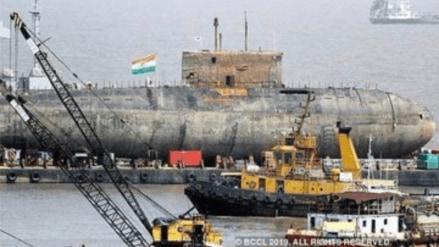In a perplexing and unfortunate turn of events, the Indian Navy’s INS Brahmaputra warship, which was docked at the Mumbai Dockyard for refitting, overturned under mysterious circumstances. The incident, which began with a fire breaking out on Sunday, has led to significant damage to the vessel and a sailor reported missing.
On Sunday evening, a fire broke out aboard the INS Brahmaputra, a multi-role frigate, while it was undergoing refit at the Naval Dockyard in Mumbai. According to Navy spokesperson Commander Vivek Madhwal, the fire was brought under control by Monday morning with the assistance of firefighters stationed at the dockyard and other warships present at the port. However, the damage assessment revealed substantial harm caused by the fire.
The situation worsened on Monday afternoon when the Brahmaputra suddenly overturned towards the port. Despite concerted efforts, the warship could not be righted. While all sailors on board were safely evacuated, one sailor remains unaccounted for, and the search for the missing personnel continues.
About INS Brahmaputra
The INS Brahmaputra, approximately 125 meters long and weighing about 4,000 tons, was built by the Garden Reach Shipbuilders and Engineers in Kolkata and commissioned into the Indian Navy in 2000. It is equipped with a range of weapons, including surface-to-surface missiles, surface-to-air missiles, medium-range guns, anti-submarine rockets, radars, sonars, and electronic warfare systems. The ship also has the capability to deploy a helicopter and has been involved in numerous long-distance missions and rescue operations, including Operation Sukoon in 2006, which evacuated Indian nationals from Lebanon during the Israel-Hezbollah conflict.
Investigation Ordered
The Indian Navy has ordered an investigation into the latest incident involving INS Brahmaputra. The inquiry aims to uncover the cause of the fire and the subsequent capsizing of the warship. Given the extent of the damage, it appears unlikely that the vessel can be salvaged.
The INS Brahmaputra incident is a stark reminder of the challenges and risks faced by the Indian Navy. Over the past decade, the navy has experienced several high-profile accidents that have raised concerns about safety protocols and the operational readiness of its fleet.
Previous Incidents
This incident is not an isolated one; the Indian Navy has faced a series of accidents involving its vessels over the years.
In 2016, a similar incident occurred when INS Betwa, another frigate of the same class, capsized while undocking at the same naval dockyard. That accident resulted in the tragic loss of two sailors and injuries to 14 others. INS Betwa had previously run aground and collided with an unidentified object in 2014, adding to the string of mishaps.
In 2011, the frigate INS Vindhyagiri sank after a collision with a merchant vessel, MV Nordlake, while entering the Mumbai dockyard. The collision resulted in a fire that caused the ship to capsize. Similarly, in 2013, a fire broke out on India’s only aircraft carrier at the time, INS Viraat, off the coast of Mumbai.
String of Incidents related to frigates, nuclear submarines and other naval ships
The year 2014 was particularly challenging for the Indian Navy, marked by multiple incidents. The tank-landing ship INS Airavat ran aground in Visakhapatnam, causing severe damage to its propellers. Later that year, a fire onboard the Russian-made submarine INS Sindhuratna led to the resignation of the then-Indian Navy chief, Admiral DK Joshi, who took moral responsibility for the string of accidents under his command.
In 2014, another Russian-made submarine, INS Sindhurakshak, exploded and sank while docked in Mumbai, resulting in the loss of 18 crew members. This was one of the worst maritime disasters in India’s recent history.
Based on the information available in the public domain, in 2017, India’s first indigenously developed nuclear-powered ballistic submarine, INS Arihant, was rendered inoperative after an aft hatch was left open, causing seawater to flood the propulsion area. The submarine was out of operation for 10 months and had to undergo extensive repairs. The incident underscored the critical importance of adhering to stringent safety protocols, especially for strategic assets like nuclear submarines.
It has been reported previously, the INS Chakra, a nuclear submarine leased from Russia, also suffered damage to its sonar domes while entering the Visakhapatnam harbour in 2017. Although the INS Chakra’s primary role is training and escorting, the damage highlighted vulnerabilities in the operational deployment of India’s naval assets.
The repeated incidents involving naval vessels, from frigates to nuclear submarines, point to a need for robust safety measures and thorough investigations to prevent future mishaps. The Indian Navy’s operational capabilities are crucial, not only for national security but also for maintaining its role as a first responder in the Indian Ocean Region and contributing to international maritime security.
In conclusion, the overturning of INS Brahmaputra adds to a troubling list of naval accidents that have plagued the Indian Navy in recent years. The incident calls for immediate and comprehensive investigations to identify and address the root causes. Strengthening safety protocols and ensuring rigorous adherence to operational procedures will be vital in safeguarding the lives of sailors and the integrity of India’s naval fleet. As the search continues for the missing sailor and the investigation progresses, the Indian Navy must take decisive steps to enhance its safety culture and operational resilience.
Reaction on the Social Media
https://twitter.com/realkaypius/status/1815409221283799051
“Difficult to reconcile how an activity like firefighting meant to fight one calamity (fire) leads to another (flooding/capsize). IN ships Taragiri (1994), Vindhyagiri (2011) & now Brahmaputra. A very disturbing set & dubious distinction. Serious introspection/correction reqd.”
